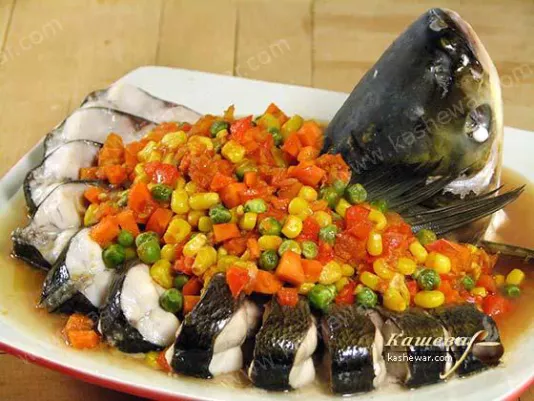Zucchini Fritters with Hot Pepper
Zucchini pancakes with hot peppers are a Chinese recipe that is very good for breakfast.

Chinese cuisine is one of the most ancient and influential culinary traditions in the world. It has developed over millennia, incorporating philosophical ideas of harmony, balance, and seasonality. Its foundation is simple ingredients: rice, noodles, vegetables, soy products, meat, seafood. Yet through advanced cooking techniques and a deep understanding of flavor composition, these are transformed into refined dishes. Chinese cuisine is known for fast cooking over high heat, a combination of spicy, sweet, sour, and salty flavors, and the use of natural ingredients and spices that not only enhance taste but also offer health benefits. Traditional Chinese dining involves sharing – many small, hot dishes served in the center of the table. This is a cuisine where each region has its own story and culinary language.
Recipes in Chinese cuisine are based on harmony of taste, color, texture, and aroma. The most famous dishes include wok noodles, Peking duck, sweet and sour pork, dim sum (Chinese dumplings), vegetable fried rice, Sichuan tofu, and Kung Pao chicken. Cooking is fast, often done in a wok – a deep pan that provides high heat and preserves the texture of ingredients. Many dishes are prepared by braising, steaming, or stir-frying in oil. Techniques vary by product type, season, and region. Meals are typically served with rice or noodles as a side. Chinese cuisine avoids excessive fats, instead highlighting natural flavors where vegetables remain crisp and meats stay juicy. Every recipe requires precision and knowledge of proper ingredient pairing.
China is traditionally divided into eight major culinary regions, each with unique techniques and flavors. Sichuan features spicy dishes with chili, garlic, ginger, and the famous Sichuan pepper. Cantonese (Guangdong) cuisine is light and delicate, emphasizing seafood, soups, and dim sum. Shandong is known for imperial-style dishes, braised meats, and sea fish. Hunan offers spicy, aromatic foods, similar to Sichuan but with more vinegar. Jiangsu cuisine is refined, with soft textures and sweet-leaning sauces, often using seafood. Fujian cuisine includes clear soups, rice dishes, and gentle cooking techniques. Zhejiang focuses on light, refreshing dishes with vegetables and fish. Anhui highlights rural flavors with forest mushrooms, herbs, and game meats. This regional variety makes Chinese cuisine an endless source of culinary exploration.
Chinese cuisine is built on essential ingredients: rice, noodles (wheat or rice-based), vegetables, tofu, pork, chicken, beef, duck, and seafood. Mushrooms, bamboo shoots, cabbage, ginger, garlic, and scallions are frequently used. Indispensable sauces include soy sauce, oyster sauce, rice vinegar, sesame oil, and chili sauce. Chinese spices offer both aroma and healing effects: Sichuan pepper, star anise, cloves, cinnamon, cardamom, fennel, and ginger. Seasoning blends like five-spice powder symbolize flavor balance. Dairy products are rarely used, making the food light and digestible. The flavor profile of Chinese cuisine spans all possible combinations: sweet, sour, spicy, salty, bitter – all in perfect harmony.
Chinese culinary philosophy is grounded in the concept of “yin and yang,” reflected in the balance of cold and hot, spicy and mild, soft and crunchy. Dishes are prepared using stir-frying (chao), braising (men), steaming (zheng), boiling (zhu), and roasting (kao). The wok is the central cooking tool, enabling fast stir-frying while preserving flavor. Meals are served family-style: all dishes are placed in the center, and everyone eats with chopsticks. Dining is not just nourishment but a moment of togetherness with family or friends. Dishes are crafted with attention to color, shape, and texture. The ideal dish is vibrant, aromatic, and balanced. Seasonality and adaptation to climate and personal health also play important roles.
Chinese desserts are less sweet than their Western counterparts. They include lotus seed jelly, sticky rice balls in ginger syrup, red bean paste, sweet tofu, and chrysanthemum jelly. Tea is the most important beverage – green, oolong, pu-erh, jasmine, and white teas are consumed throughout the day, accompany meals, and are part of spiritual culture. Chinese cuisine is not just about food but a worldview – respect for nature, knowledge of the body, seasonal approaches, and minimalism in presentation. It continues to evolve while preserving its millennia-old traditions. Its influence can be seen in the cuisines of Vietnam, Japan, Korea, and Thailand. Even today, Chinese cuisine remains a benchmark of balance, depth of flavor, and wisdom.